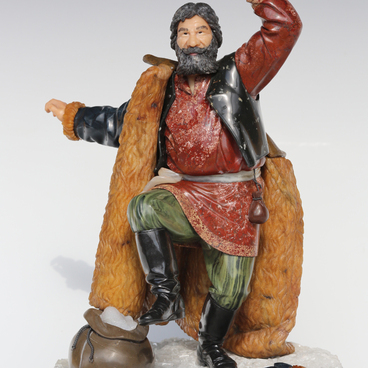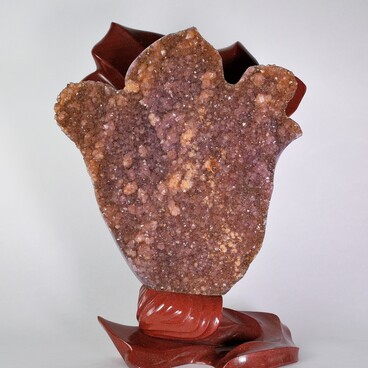A mineralogical hill made of ornamental stones is displayed in the “Bazhov hall” of the Museum of Stone-Cutting and Jewelry Art History. It was created in 1982 by Pavel Baranov, a geologist from the city of Sysert, Sverdlovsk Oblast.
Sysert (formerly — the Sysert Plant) was Pavel Bazhov’s home city, who was famous for his Ural fairy tales. Pavel Baranov often turned to the plots of his works, especially to the fairy tale “The Mistress of the Copper Mountain”. The hero of the fairy tale was a mountain master Stepan: the mistress of the mountain offered him her love and rich domains in the mountain kingdom. However, Stepan refused, and then the Mistress for his honesty gave him dowry for his bride — a malachite jewelry box.
Baranov created a small cave on the front side of the hill where he placed an image of the Mistress of the Copper Mountain with a lizard in her hand. The floor of the cave was laid out with rock crystal. On the back side, Baranov reproduced a mine shaft in section and placed a pail with malachite in it. On the right side, there is a small grotto, decorated with chalcedony, garnet, pyrite and malachite.
The exhibit item is mainly made of Ural minerals. The master, however, used other stones, which were mined in other regions of the Soviet Union. Here one can see different types of jasper, smoky and milky quartz, carnelian, fluorite, as well as a rare charoite — a bright purple mineral which is not mined in Russia anymore.
Seams between stones are hidden by pieces and small crystals of pyrite. The entire structure, 105 cm in length, is mounted on a stand lined with listwanite — an ornamental stone of green color.
Such hills, made of Ural stones, were popular souvenirs at the end of the 18th century. The stones for them were not processed, or they were slightly ground, but artists tried to preserve their natural shape. The hill base was made of metal and dark stone to which pieces of various minerals were randomly attached. Seams between them were covered with stone crumb.
At the end of the 19th century, the most popular mineralogical hills were created by Alexey Denisov-Uralsky. They were displayed at major Russian and international exhibitions, and bought by merchants and aristocrats. Presently, many of them are lost, some are kept in private collections, but some copies are housed in Russian museums.
Sysert (formerly — the Sysert Plant) was Pavel Bazhov’s home city, who was famous for his Ural fairy tales. Pavel Baranov often turned to the plots of his works, especially to the fairy tale “The Mistress of the Copper Mountain”. The hero of the fairy tale was a mountain master Stepan: the mistress of the mountain offered him her love and rich domains in the mountain kingdom. However, Stepan refused, and then the Mistress for his honesty gave him dowry for his bride — a malachite jewelry box.
Baranov created a small cave on the front side of the hill where he placed an image of the Mistress of the Copper Mountain with a lizard in her hand. The floor of the cave was laid out with rock crystal. On the back side, Baranov reproduced a mine shaft in section and placed a pail with malachite in it. On the right side, there is a small grotto, decorated with chalcedony, garnet, pyrite and malachite.
The exhibit item is mainly made of Ural minerals. The master, however, used other stones, which were mined in other regions of the Soviet Union. Here one can see different types of jasper, smoky and milky quartz, carnelian, fluorite, as well as a rare charoite — a bright purple mineral which is not mined in Russia anymore.
Seams between stones are hidden by pieces and small crystals of pyrite. The entire structure, 105 cm in length, is mounted on a stand lined with listwanite — an ornamental stone of green color.
Such hills, made of Ural stones, were popular souvenirs at the end of the 18th century. The stones for them were not processed, or they were slightly ground, but artists tried to preserve their natural shape. The hill base was made of metal and dark stone to which pieces of various minerals were randomly attached. Seams between them were covered with stone crumb.
At the end of the 19th century, the most popular mineralogical hills were created by Alexey Denisov-Uralsky. They were displayed at major Russian and international exhibitions, and bought by merchants and aristocrats. Presently, many of them are lost, some are kept in private collections, but some copies are housed in Russian museums.



